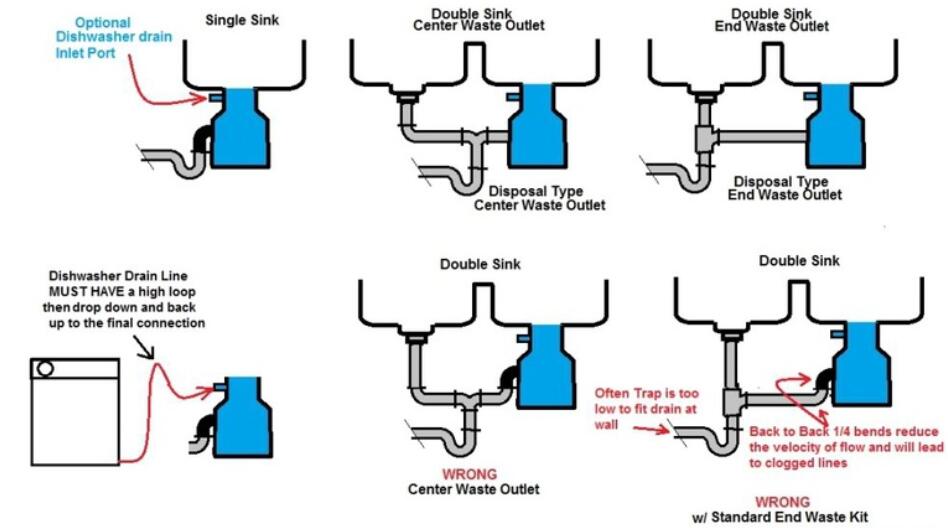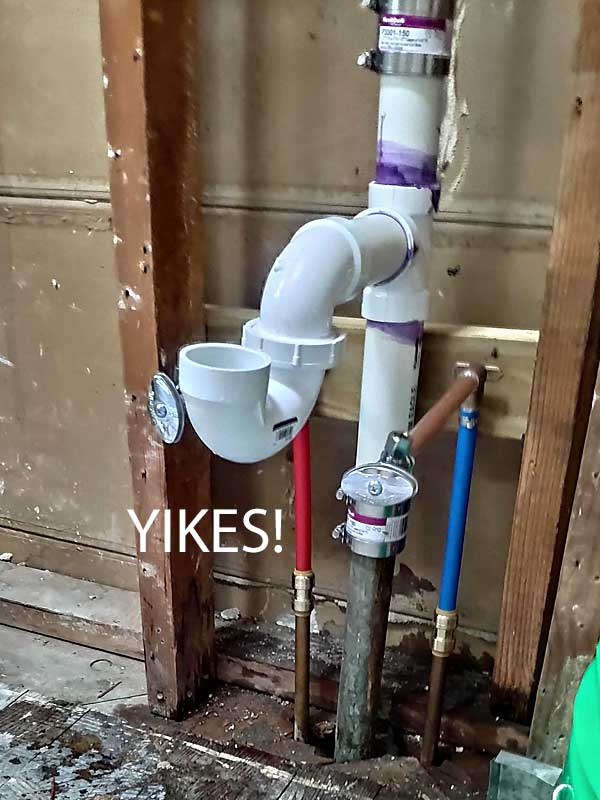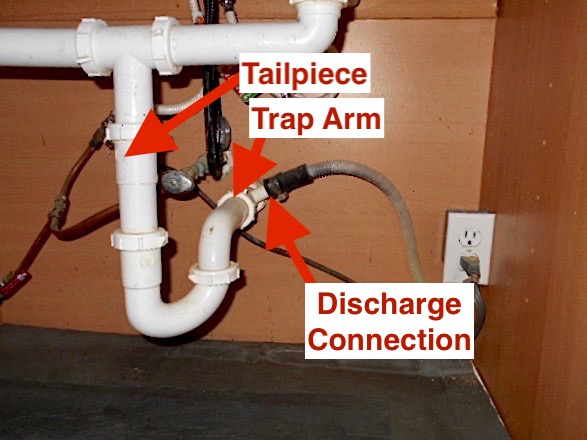Installing a kitchen sink drain may seem like a daunting task, but with the right tools and a bit of know-how, it can be a simple DIY project. Here are the steps to follow: Gather your materials: Before you begin, make sure you have all the necessary materials on hand. This includes a new kitchen sink drain, plumber's putty, Teflon tape, a pipe wrench, and a screwdriver. Remove the old drain: Start by removing the old drain. Use a pipe wrench to loosen and remove the drain from the sink. You may need to use some force to break the seal of the plumber's putty. Prepare the new drain: Take your new drain and apply a thin layer of plumber's putty around the edge of the flange. This will help create a watertight seal when the drain is installed. Install the drain basket: Place the drain basket into the sink from the top. Underneath, secure it in place with the rubber gasket and mounting ring. Use a pipe wrench to tighten the mounting ring to the drain basket. Attach the drain pipe: Next, attach the drain pipe to the bottom of the drain basket. Use Teflon tape on the threads to create a tight seal. Ensure that the pipes are aligned properly before tightening the connections with a pipe wrench. Install the drain trap: The drain trap is what prevents sewer gases from entering your home. Install the trap onto the end of the drain pipe and secure it with a pipe wrench. Make sure the trap is facing the correct direction to avoid any future issues. Connect the garbage disposal and dishwasher: If you have a garbage disposal or dishwasher, you will need to connect them to the drain. Follow the manufacturer's instructions for proper installation and use Teflon tape to ensure a tight seal. Test for leaks: Once everything is installed, turn on the water and check for any leaks. If you notice any, tighten the connections or add more plumber's putty as needed.How to Install a Kitchen Sink Drain
Installing a kitchen sink drain pipe is a crucial step in any kitchen sink plumbing project. Here's how to do it: Remove the old drain pipe: Start by removing the old drain pipe. Use a pipe wrench to loosen and remove the connections at both ends of the pipe. You may need to use some force to break the seal. Prepare the new pipe: Take your new drain pipe and apply Teflon tape to the threads. This will create a tight seal when the pipe is connected. Connect the pipe to the drain basket: Attach one end of the pipe to the bottom of the drain basket. Use a pipe wrench to tighten the connection. Make sure the pipe is aligned properly before tightening. Attach the other end to the drain trap: The other end of the pipe should be connected to the drain trap. Again, use Teflon tape on the threads and ensure the connection is tight with a pipe wrench. Test for leaks: Turn on the water and check for any leaks. If necessary, tighten the connections or add more Teflon tape to create a watertight seal.How to Install a Kitchen Sink Drain Pipe
A kitchen sink drain assembly is made up of multiple parts, including the drain basket, flange, and strainer. Here's how to install it: Remove the old assembly: Start by removing the old drain assembly. Use a pipe wrench to loosen and remove the connections at both ends of the drain pipe. Prepare the new assembly: Take your new drain assembly and apply a thin layer of plumber's putty around the edge of the flange. This will create a watertight seal when the assembly is installed. Attach the drain basket: Place the drain basket into the sink and secure it in place with the rubber gasket and mounting ring. Use a pipe wrench to tighten the mounting ring to the drain basket. Connect the drain pipe: Next, connect the drain pipe to the bottom of the drain basket. Use Teflon tape on the threads for a tight seal and ensure the pipes are aligned properly before tightening the connections with a pipe wrench. Install the drain trap: The drain trap is what prevents sewer gases from entering your home. Install the trap onto the end of the drain pipe and secure it with a pipe wrench. Make sure the trap is facing the correct direction. Test for leaks: Turn on the water and check for any leaks. If needed, adjust the connections or add more plumber's putty to create a watertight seal.How to Install a Kitchen Sink Drain Assembly
The drain basket is the part of the kitchen sink drain that sits in the sink and collects food scraps and debris. Here's how to install it: Remove the old drain basket: Start by removing the old drain basket. Use a pipe wrench to loosen and remove the connections at the bottom of the basket. Prepare the new basket: Take your new drain basket and apply a thin layer of plumber's putty around the edge. This will create a watertight seal when the basket is installed. Place the basket into the sink: Insert the basket into the sink from the top. Underneath, secure it in place with the rubber gasket and mounting ring. Use a pipe wrench to tighten the mounting ring to the basket. Test for leaks: Turn on the water and check for any leaks. If necessary, tighten the connections or add more plumber's putty to create a watertight seal.How to Install a Kitchen Sink Drain Basket
The drain trap is an essential part of the kitchen sink drain that prevents sewer gases from entering your home. Here's how to install it: Remove the old drain trap: Start by removing the old drain trap. Use a pipe wrench to loosen and remove the connections at both ends of the trap. Prepare the new trap: Take your new drain trap and apply Teflon tape to the threads. This will create a tight seal when the trap is connected. Attach the trap to the drain pipe: One end of the trap should be connected to the drain pipe. Use a pipe wrench to tighten the connection. Attach the other end to the drain basket: The other end of the trap should be connected to the bottom of the drain basket. Use Teflon tape on the threads and ensure the connection is tight with a pipe wrench. Test for leaks: Turn on the water and check for any leaks. If needed, tighten the connections or add more Teflon tape to create a watertight seal.How to Install a Kitchen Sink Drain Trap
If you have a garbage disposal, you will need to install a kitchen sink drain that accommodates it. Here's how to do it: Remove the old drain: Start by removing the old drain. Use a pipe wrench to loosen and remove the connections at both ends of the drain pipe. Prepare the new drain: Take your new drain and apply a thin layer of plumber's putty around the edge of the flange. This will create a watertight seal when the drain is installed. Install the drain basket: Place the drain basket into the sink and secure it in place with the rubber gasket and mounting ring. Use a pipe wrench to tighten the mounting ring to the drain basket. Connect the drain pipe: Next, connect the drain pipe to the bottom of the drain basket. Use Teflon tape on the threads for a tight seal and ensure the pipes are aligned properly before tightening the connections with a pipe wrench. Attach the garbage disposal: Follow the manufacturer's instructions to attach the garbage disposal to the drain pipe. Use Teflon tape to create a tight seal. Test for leaks: Turn on the water and check for any leaks. If necessary, tighten the connections or add more plumber's putty to create a watertight seal.How to Install a Kitchen Sink Drain with Garbage Disposal
If you have a dishwasher, you will need to install a kitchen sink drain that accommodates it. Here's how to do it: Remove the old drain: Start by removing the old drain. Use a pipe wrench to loosen and remove the connections at both ends of the drain pipe. Prepare the new drain: Take your new drain and apply a thin layer of plumber's putty around the edge of the flange. This will create a watertight seal when the drain is installed. Install the drain basket: Place the drain basket into the sink and secure it in place with the rubber gasket and mounting ring. Use a pipe wrench to tighten the mounting ring to the drain basket. Connect the drain pipe: Next, connect the drain pipe to the bottom of the drain basket. Use Teflon tape on the threads for a tight seal and ensure the pipes are aligned properly before tightening the connections with a pipe wrench. Attach the dishwasher: Follow the manufacturer's instructions to attach the dishwasher to the drain pipe. Use Teflon tape to create a tight seal. Test for leaks: Turn on the water and check for any leaks. If necessary, tighten the connections or add more plumber's putty to create a watertight seal.How to Install a Kitchen Sink Drain with Dishwasher
If your kitchen sink drain is damaged or no longer functioning properly, it may need to be replaced. Here's how: Remove the old drain: Use a pipe wrench to loosen and remove the old drain. You may need to use some force to break the seal. Clean the area: Before installing the new drain, clean the area thoroughly to ensure a proper seal. Install the new drain: Follow the steps outlined in the previous sections to install the new drain. Make sure all connections are tight and there are no leaks.How to Replace a Kitchen Sink Drain
A leaky kitchen sink drain can be a frustrating and costly issue. Here's how to fix it: Identify the source of the leak: First, determine where the leak is coming from. It could be the drain basket, drain pipe, or drain trap. Tighten the connections: Use a pipe wrench to tighten any loose connections. This may solve the issue if the leak is coming from a loose connection. Replace damaged parts: If the leak persists, you may need to replace damaged parts, such as the drain basket or drain pipe. Use plumber's putty or Teflon tape: If the leak is coming from the drain basket, use plumber's putty or Teflon tape on the threads to create a watertight seal.How to Fix a Leaky Kitchen Sink Drain
A clogged kitchen sink drain is a common issue that can be easily fixed. Here's how to unclog it: Use a plunger: Place a plunger over the drain and plunge vigorously. This may dislodge the clog and allow the water to drain. Try a drain snake: If the plunger doesn't work, you can try using a drain snake to physically remove the clog. Use a mixture of baking soda and vinegar: Pour a cup of baking soda down the drain, followed by a cup of vinegar. Let it sit for a few minutes before flushing with hot water. This can help break up and dissolve the clog. Call a professional: If none of the above methods work, it's best to call a professional plumber to properly unclog your kitchen sink drain.How to Unclog a Kitchen Sink Drain
The Importance of Properly Installed Kitchen Sink Plumbing in Manufactured Homes

Why Kitchen Sink Plumbing Matters
 Properly installed kitchen sink plumbing is a crucial aspect of any manufactured home design. Not only does it play a significant role in the functionality and efficiency of your kitchen, but it also plays a key role in the overall value and appeal of your home. Whether you are building a new manufactured home or currently living in one, it is important to understand the importance of properly installed kitchen sink plumbing and its impact on your daily life.
Properly installed kitchen sink plumbing is a crucial aspect of any manufactured home design. Not only does it play a significant role in the functionality and efficiency of your kitchen, but it also plays a key role in the overall value and appeal of your home. Whether you are building a new manufactured home or currently living in one, it is important to understand the importance of properly installed kitchen sink plumbing and its impact on your daily life.
The Potential Dangers of Poorly Installed Kitchen Sink Plumbing
 Poorly installed kitchen sink plumbing can result in a range of problems, from minor inconveniences to major safety hazards. Leaks, clogs, and slow draining sinks can disrupt your daily routine and cause frustration. Additionally, if not properly installed, kitchen sink plumbing can lead to potential water damage, which can be costly to repair. Furthermore, poorly installed plumbing can also pose a risk of contamination, affecting the safety and cleanliness of your home.
Poorly installed kitchen sink plumbing can result in a range of problems, from minor inconveniences to major safety hazards. Leaks, clogs, and slow draining sinks can disrupt your daily routine and cause frustration. Additionally, if not properly installed, kitchen sink plumbing can lead to potential water damage, which can be costly to repair. Furthermore, poorly installed plumbing can also pose a risk of contamination, affecting the safety and cleanliness of your home.
The Benefits of Properly Installed Kitchen Sink Plumbing
 On the other hand, having properly installed kitchen sink plumbing can bring numerous benefits to your manufactured home. Firstly, it ensures a smooth and efficient flow of water, making your daily tasks in the kitchen easier and more convenient. Secondly, it helps to prevent leaks and clogs, saving you time and money on potential repairs. Lastly, properly installed plumbing can increase the value and appeal of your home, making it more attractive to potential buyers in the future.
On the other hand, having properly installed kitchen sink plumbing can bring numerous benefits to your manufactured home. Firstly, it ensures a smooth and efficient flow of water, making your daily tasks in the kitchen easier and more convenient. Secondly, it helps to prevent leaks and clogs, saving you time and money on potential repairs. Lastly, properly installed plumbing can increase the value and appeal of your home, making it more attractive to potential buyers in the future.
Professional Installation is Key
 To ensure that your kitchen sink plumbing is properly installed, it is essential to hire a professional plumber. A licensed and experienced plumber can ensure that all the pipes, fixtures, and connections are correctly installed, preventing any potential issues in the future. They can also provide guidance on the best materials and design for your specific kitchen sink and layout, ensuring optimal functionality and longevity.
To ensure that your kitchen sink plumbing is properly installed, it is essential to hire a professional plumber. A licensed and experienced plumber can ensure that all the pipes, fixtures, and connections are correctly installed, preventing any potential issues in the future. They can also provide guidance on the best materials and design for your specific kitchen sink and layout, ensuring optimal functionality and longevity.
Conclusion
 In conclusion, properly installed kitchen sink plumbing is a crucial aspect of manufactured home design. It not only affects the functionality and efficiency of your kitchen but also plays a significant role in the safety and value of your home. By understanding the importance of properly installed plumbing and hiring a professional for installation, you can enjoy a hassle-free and functional kitchen for years to come.
In conclusion, properly installed kitchen sink plumbing is a crucial aspect of manufactured home design. It not only affects the functionality and efficiency of your kitchen but also plays a significant role in the safety and value of your home. By understanding the importance of properly installed plumbing and hiring a professional for installation, you can enjoy a hassle-free and functional kitchen for years to come.




/how-to-install-a-sink-drain-2718789-hero-b5b99f72b5a24bb2ae8364e60539cece.jpg)


:max_bytes(150000):strip_icc()/how-to-install-a-sink-drain-2718789-hero-24e898006ed94c9593a2a268b57989a3.jpg)




:max_bytes(150000):strip_icc()/how-to-install-a-sink-drain-2718789-04-5715d67f5b7d41429d42bf705bb70e2c.jpg)



















/sink-drain-trap-185105402-5797c5f13df78ceb869154b5.jpg)




































:max_bytes(150000):strip_icc()/freshen-and-unclog-drain-with-baking-soda-1900466-22-bbf940b70afa4d5abef0c54da23b1d3f.jpg)
:max_bytes(150000):strip_icc()/how-to-unclog-a-kitchen-sink-2718799_sketch_FINAL-8c5caa805a69493ab22dfb537c72a1b7.png)












